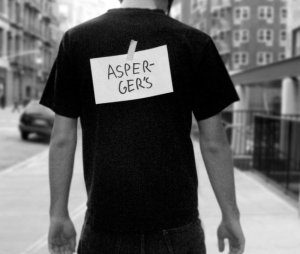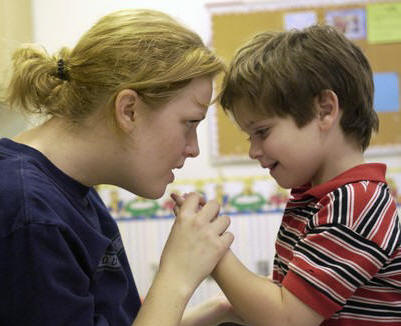By ALICE PARK | @aliceparkny
Early intervention may help curb some of the more severe symptoms of autism. The question is, How do we identify at-risk children early enough?
Researchers say they may soon be able to identify babies at high risk of autism as early as 6 months old.
Currently, clinicians can’t diagnose autism until toddlers are about 2, when the first behavioral and language symptoms of the developmental disorder become noticeable. There is a push to identify at-risk babies earlier, though, since early intervention may be critical for halting abnormal development and preventing the most troublesome behavioral outcomes associated with autism. But while scientists are developing more sophisticated screening tests that rely on brain-imaging techniques or eye-tracking technologies that monitor an infant’s gaze to pick up early autistic signs, there is still no reliable way to diagnose the condition in younger infants.
 Now, reporting in the American Journal of Psychiatry, researchers say that they may finally have a tool that will select out the highest-risk infants at just 6 months old. The innovative test, known as fractional anisotropy, measures the density of white matter, the part of brain that is rich in nerve fibers and makes up the major neural pathways that connect various regions of the brain. Specifically, the technology measures the diffusion of water through nerve-fiber tracts to gauge the density of myelin, the substance that insulates the sometimes long fibers that connect one nerve cell to another; the density of myelin serves as a rough stand-in for the density of neural connections in the brain.
Now, reporting in the American Journal of Psychiatry, researchers say that they may finally have a tool that will select out the highest-risk infants at just 6 months old. The innovative test, known as fractional anisotropy, measures the density of white matter, the part of brain that is rich in nerve fibers and makes up the major neural pathways that connect various regions of the brain. Specifically, the technology measures the diffusion of water through nerve-fiber tracts to gauge the density of myelin, the substance that insulates the sometimes long fibers that connect one nerve cell to another; the density of myelin serves as a rough stand-in for the density of neural connections in the brain.
The scientists, recruited 92 children from the Infant Brain Imaging Study Network, which includes four clinical sites around the country. All the infants were considered to be at higher risk of developing autism because they each had at least one older sibling affected by the disorder.
The researchers monitored the children’s brain and behavior development. At 6, 12 and 24 months, the scientists measured the density of the babies’ nerve fibers in the brain, and then tracked them to see who would end up being diagnosed with an autism spectrum disorder (ASD) by age 2 and who did not.
Children who were eventually diagnosed with ASDs were more likely to show thicker, denser nerve-fiber readings at 6 months, compared with normally developing children. But by the time the infants were 2, the situation was reversed: the ASD toddlers had thinner white matter than those who did not develop autism.
“The findings suggest that early on, there is something different going on in children who develop ASDs,” says Geraldine Dawson, chief science officer of Autism Speaks who is also a professor of psychiatry at University of North Carolina Chapel Hill and a co-author of the paper. “Very early on, before the emergence of behavioral symptoms, these neural networks that connect different brain regions are not developing normally.”
Among the 15 nerve-fiber tracts in the brain that linked various regions together, 12 showed aberrant growth patterns in the 6-month old babies who developed ASDs compared with those who didn’t. This suggests, says Dawson, that “there is a more global change in development of these tracts implicated in autism, and that functional connectivity, or the establishment of neural networks is clearly implicated in these findings.”
That means that whatever biological processes are driving autism, they aren’t limited to one region of the brain. And that makes sense, since the disorder’s hallmark behavioral symptoms involve language and social interactions, which require exquisite coordination of several different brain areas.
Dawson and her colleagues stress, however, that their results do not necessarily suggest that the explosion of white matter at 6 months and its subsequent drop-off cause the abnormal development that leads to autism. For now, it’s just an intriguing potential marker for the disorder, one that may help doctors identify infants at highest risk of developing autism early on. Because the study involved only children with a family history of ASD, the next step will be to compare these infants with those whose families are not affected. (There is evidence that even unaffected siblings of autistic children have similar brain changes to those of their autistic brothers and sisters, and may even exhibit subtle symptoms of the disorder.)
A better understanding of how the autistic brain works could, of course, help scientists develop better therapies to treat the disorder. Better interventions could even help prevent ASDs from progressing to more advanced stages that keep children and adults from becoming functioning members of society.
Detecting the first signs of autism, perhaps even in infants younger than 6 months, may be an important part of that effort as well. Studies show, for example, that toddlers on the road to autism who are engaged in language and social-skills therapy can improve their cognitive development and IQ score by as much as 17 points. “One can imagine a day [when], if a baby is suspected of being at risk of developing autism, one could use a biomarker test like this one to identify infants who should perhaps receive early stimulation in language and social development so they can improve their outcomes,” says Dawson. That’s the goal, and tests like these can bring us one step closer toward achieving it.
Related Articles:
- The Autistic Brain at 6 Months (theness.com)
- New Findings Hold Promise for Revolutionary Pre-Symptom Screening (autismspeaks.org)
- The Joint Statement of the Autism Society and Autistic Self Advocacy Network on the DSM-5 and Autism (pdresources.wordpress.com)








